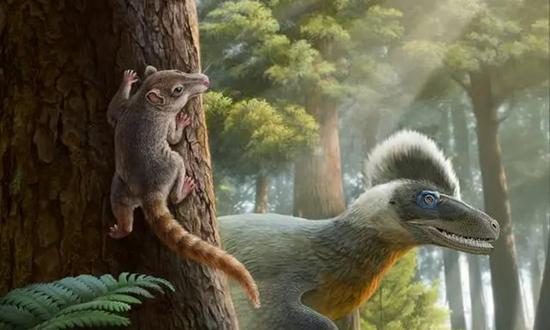
A reconstructed image of the newly identified eutherian mammal (left) (Photo/Courtesy of Chinese Academy of Sciences)
Scientists from the Chinese Academy of Sciences (CAS) have identified a new eutherian mammal that has revealed the middle ear structure of a eutherian mammal for the first time, filling a gap in the evolution of the middle ear from 120 million years ago. In the early Cretaceous era, according to a recent report in Science and Technology Daily.
The results of this study have been published in the prestigious journal Nature Communications.
The mammalian middle ear has long been considered a classic case of gradual evolution. Previous studies have shown that the transition from the mandible to the middle ear occurred in two evolutionary stages, eventually leading to the separation of the middle ear bones from the mandible.
„Although this evolutionary event occurred many times in different lineages of Mesozoic mammals, there is little direct evidence of middle ear evolution in mammalian ancestors closely related to humans,” explained Wang Haibing, first author of the paper and a researcher at the Vertebrate Institute. Paleontology and Paleoanthropology of CAS.
Several years ago, a team led by researcher Wang Yuanqing from the same institute discovered a Cretaceous mammal fossil dating back to about 120 million years ago in the Jiufodong Formation of Yixian Basin, Liaoning Province, Northeast China.
After restoration, researchers used high-precision CT scanning and 3D reconstruction techniques to examine the fossil. They identified it as a new species of early Cretaceous eutherian mammal and named it Microtherulum onerodes.
„The common name micro refers to the microtype configuration of the middle ear; terulam, small animal. The specific name oneirodes (Greek), dreamlike, refers to a dreamlike fossil finding that fills a gap in middle ear evolution of early therians,” according to the paper.
„The dreamlike feature of this creature is that it exhibits typical features of the middle ear of modern mammals as one of the earliest eutherian mammals, filling a gap in the early evolution of the mammalian middle ear,” Wang said.
„Compared to finding new species with strange and unimaginable origins, this long-awaited and long-awaited fossil discovery adds extra excitement and joy to our research,” he added.
The research team reconstructed the skull morphology of the creature and reported, for the first time, the bone morphology of the middle ear bones in an early Cretaceous eutherian mammal.
„The Meckelian groove in the creature’s mandible was completely destroyed, indicating that the middle ear bones were completely separated from the mandible, revealing the characteristic features of typical mammalian middle ears,” Wang said.
According to Wang, this result differs from Coccotherium jiufotangensis, a new eutherian species discovered from the Jiufotang Formation, which still retains a smooth Meckelian groove. This suggests that there is a certain degree of variation in middle ear morphology, even among closely related species at early stages of mammalian evolution.
In addition, the research team integrated recent phylogenetic frameworks to discuss the evolutionary trends of early mammalian hearing and feeding organs, proposing that the divergence of mammalian hearing and feeding organs occurred independently.
The evolution of the auditory organs (middle ear, inner ear) and refinement of the tryposphenic structure in early Cretaceous eutherian mammals laid an important foundation for the improved hearing and expanded ecological niche of modern mammals, the report says.

„Oddany rozwiązywacz problemów. Przyjazny hipsterom praktykant bekonu. Miłośnik kawy. Nieuleczalny introwertyk. Student.


